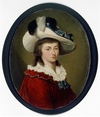GINGRAS, ÉDOUARD (baptized François-Édouard), wheelwright and master coach-builder; b. 3 June 1806 at Quebec, son of Pierre Gingras, a merchant, and Marguerite Gaboury; m. there 3 July 1827 Louise Contremine, dit Jolicœur, and they had 11 children; d. there 22 Sept. 1857.
Édouard Gingras, the seventh of a family of ten, was married at the age of 21 in a ceremony which both his father and his brother Léon attended. By then Gingras was a recognized wheelwright, and he soon opened his own workshop in the town, probably on Rue d’Aiguillon. In 1833 notarized acts designated him master coach-builder; he had a number of employees, among them blacksmith François Ratté, who had joined him the preceding year and remained in his service for at least 13 years.
Gingras sought to improve his technique and to give a finish of higher quality to his vehicles. He imported many of the parts he used, as witness his prosecution in 1835 for refusing material from Ireland because he considered the price too high. Gingras was conscientious in his work; as a master in his trade and owner of a workshop he continually had to alter the designs of the various models offered to his clients: vehicles for outings, coaches, and sleighs. Every year the fashion changed and techniques became more refined. Gingras responded with imagination and efficiency. For example, aware that there were problems related to the suspension system used for carriages, on 16 Sept. 1843 he patented a “New method of making springs for vehicles.” Gingras in 1839 had become the owner of a three-storey stone house at 36 Rue Sainte-Ursule, in which he had already lived for nine years. He bought another one on the same street in 1850 and installed his equipment there. The census of the following year shows that he had ten employees.
In 1851 the Canadian government participated in the Great Exhibition in London, sending, among other products, three vehicles manufactured by Joseph Saurin of Quebec and two built by Clovis Leduc of Montreal. Within four years, in both quality and financial yield, Gingras succeeded in catching up with his competitor Saurin, whose workshop on Rue Sainte-Anne employed 20 people. The two men took part in the universal exposition held in Paris in 1855. Gingras sent a de luxe four-wheeled vehicle, Saurin a de luxe sleigh. That the two were chosen undoubtedly proves the excellence of their work, since by 1851 Lower Canada had 584 coach-builders and wheelwrights and Upper Canada 1,789. The author of a work published in Paris on the exposition spoke highly of the Canadian entries: “These vehicles are elegant in form, and the mountings in particular have been treated with great care; they speak well for the taste of the builders.” Afterwards the vehicles of Gingras and Saurin were sent to the Crystal Palace at Sydenham, southeast of London.
Gingras’s workshop at Quebec continued to produce vehicles and sleighs, and his fame steadily grew. But he died on 22 Sept. 1857, the very day that he learned he had won first prize at an exhibition held in Montreal. A master coach-builder who was concerned about the quality of his products, Gingras had also proved able to set up a business dealing in superior finished articles and to run it successfully. His son Édouard, who worked with him, took over the business, and in partnership with his father-in-law, Charles Hough, increased its importance. By 1871 the undertaking was by far the largest coachmaker’s establishment in Quebec County. In that year the 23 employees produced 407 winter and summer vehicles, most of them with silver fittings.
ANQ-Q, CE1-1, 3 juin 1806, 3 juill. 1827, 25 sept. 1857; CN1-138, 30 juill. 1835; CN1-219, 22 mars 1833, 22 janv. 1845. AVQ, VII, E, 1, quartier Saint-Louis, 1830–56. PAC, RG 31, A1, 1851, 1871, Quebec. [J.-C. Taché], Le Canada et l’exposition universelle de 1855 (Toronto, 1856). Journal of Education for Lower Canada (Montreal), 1 (1857): 138.
© 1985–2024 University of Toronto/Université Laval
Cite This Article
Anne Bernatchez, “GINGRAS, ÉDOUARD (baptized François-Édouard),” in Dictionary of Canadian Biography, vol. 8, University of Toronto/Université Laval, 2003–, accessed April 16, 2024, http://www.biographi.ca/en/bio/gingras_edouard_8E.html.
The citation above shows the format for footnotes and endnotes according to the Chicago manual of style (16th edition). Information to be used in other citation formats:
| Permalink: | http://www.biographi.ca/en/bio/gingras_edouard_8E.html |
| Author of Article: | Anne Bernatchez |
| Title of Article: | GINGRAS, ÉDOUARD (baptized François-Édouard) |
| Publication Name: | Dictionary of Canadian Biography, vol. 8 |
| Publisher: | University of Toronto/Université Laval |
| Year of publication: | 1985 |
| Year of revision: | 1985 |
| Access Date: | April 16, 2024 |






